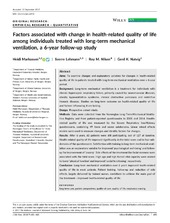| dc.contributor.author | Markussen, Heidi Øksnes | en_US |
| dc.contributor.author | Lehmann, Sverre | en_US |
| dc.contributor.author | Nilsen, Roy Miodini | en_US |
| dc.contributor.author | Natvig, Gerd Karin | en_US |
| dc.date.accessioned | 2018-03-02T14:05:59Z | |
| dc.date.available | 2018-03-02T14:05:59Z | |
| dc.date.issued | 2018-03 | |
| dc.Published | Markussen H, Lehmann S, Nilsen RM, Natvig GK. Factors associated with change in health-related quality of life among individuals treated with long-term mechanical ventilation, a 6-year follow-up study. Journal of Advanced Nursing. 2017;74(3):651-665 | eng |
| dc.identifier.issn | 0309-2402 | |
| dc.identifier.issn | 1365-2648 | |
| dc.identifier.uri | https://hdl.handle.net/1956/17489 | |
| dc.description.abstract | Aims: To examine changes and explanatory variables for changes in health-related quality of life in patients treated with long-term mechanical ventilation over a 6-year period. Background: Long-term mechanical ventilation is a treatment for individuals with chronic hypercapnic respiratory failure, primarily caused by neuromuscular diseases, obesity hypoventilation syndrome, chronic obstructive pulmonary and restrictive thoracic diseases. Studies on long-term outcome on health-related quality of life and factors influencing it are lacking. Design: Prospective cohort study. Methods: Data were collected from the Norwegian Long-Term-Mechanical-Ventilation Registry and from patient-reported questionnaire in 2008 and 2014. Healthrelated quality of life was measured by the Severe Respiratory Insufficiency questionnaire, containing 49 items and seven subdomains. Linear mixed effects models were used to measure changes and identify factors for changes. Results: After 6 years, 60 patients were still participating, out of 127 at baseline. Health-related quality of life improved significantly in the total score and in four subdomains of the questionnaire. Satisfaction with training in long-term mechanical ventilation was an explanatory variable for improved ‘psychological well-being’ and followup for improvement of ‘anxiety’. Side effects of the treatment like facial soreness were associated with the total score. High age and high forced vital capacity were related to lower ‘physical function’ and improved ‘social functioning’, respectively. Conclusion: Long-term mechanical ventilation over 6 years improved health-related quality of life in most patients. Patient training, follow-up and reduction of side effects, largely delivered by trained nurses, contribute to achieve the main goal of the treatment—improved health-related quality of life. | en_US |
| dc.language.iso | eng | eng |
| dc.publisher | Wiley | eng |
| dc.rights | Attribution CC BY-NC | eng |
| dc.rights.uri | http://creativecommons.org/licenses/by-nc/4.0/ | eng |
| dc.subject | long-term care | eng |
| dc.subject | patient perspectives | eng |
| dc.subject | quality of care | eng |
| dc.subject | Quality of life | eng |
| dc.subject | respiratory nursing | eng |
| dc.title | Factors associated with change in health-related quality of life among individuals treated with long-term mechanical ventilation, a 6-year follow-up study | en_US |
| dc.type | Peer reviewed | |
| dc.type | Journal article | |
| dc.date.updated | 2018-02-08T09:26:17Z | |
| dc.description.version | publishedVersion | en_US |
| dc.rights.holder | Copyright 2017 The Author(s) | |
| dc.identifier.doi | https://doi.org/10.1111/jan.13472 | |
| dc.identifier.cristin | 1556231 | |
| dc.source.journal | Journal of Advanced Nursing | |

